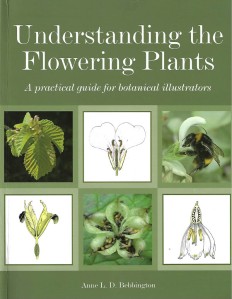 If you enjoy doodling, sketching, drawing, or painting plants, chances are you’ve had a moment in which you did not know the name or function of the plant part in front of you.
If you enjoy doodling, sketching, drawing, or painting plants, chances are you’ve had a moment in which you did not know the name or function of the plant part in front of you.
Fortunately for the contemporary botanical illustrator, there are books to help artists navigate the world of plant morphology. These books have been reviewed here in the past.
Today I have the pleasure of introducing you to a botany book that serves as a comprehensive guide to the botanical world. While written for botanical illustrators, classroom teachers will also enjoy the thorough treatment of plant biology, and naturalists will find this book to be a welcome companion in the field.
Understanding the Flowering Plants: A Practical Guide for Botanical Illustrators is a book by botanist, teacher, and botanical illustrator Anne L.D. Bebbington. It is based on material from a course Anne taught with Mary Brewin for the Institute for Analytical Plant Illustration (IAPI) back in 2010. The program they led was a botany program created specifically for botanical artists. In this course, they aimed to help botanical artists “gain a better understanding of the flowering plants and so inform their artwork” (Bebbington, 2014). Since then Anne has taught many workshops as interest in plants and botany has grown among art groups in the UK. Anne currently runs workshops as part of the Kew Illustration Course and works as a botanist/tutor in the Society of Botanical Artists Long Distance Diploma Course. Fellow IAPI members are also visiting art groups and leading workshops.
Whether you are a botanical artist entering juried exhibitions, a passionate nature journaler, or an avid gardener, Understanding the Flowering Plants is a reference not to be missed.
Anne’s book is extensive and she discusses a lot of information in the book’s 256 pages. Here are the main topics addressed in the book’s twelve chapters:
- What is a flowering plant?
- The Approach to a Botanical Study
- Tools and Techniques
- The Flowering Plant – Structure and Living Processes
- Leaves
- Roots and Stems
- Life Spans and Asexual Reproduction
- Flowers
- Sexual Reproduction
- Fruits and Seeds and Their Dispersal
- Seeds — Their Structure and Germination
- Winter Twigs
This book does not read like a typical botany book. Anne has kept the text brief and informative and uses line drawings and color photographs to illustrate the points she makes. The book’s supporting images are more than just helpful. I think they make the book and enable readers to establish a working knowledge of plants. Here are a few features I think are especially good:
Writing Plant Names
-
This section is a wonderful guide to writing plant names. Illustrators can’t go wrong following Anne’s advice.
Collecting, Storing and Reviving Specimens
This section features helpful tips for artists and gardeners.
Tools & Techniques
The Tools & Techniques chapter is filled with practical information about how to use microscopes, cameras, scanners, and computers to document plants.
Inflorescence Types
Inflorescences are clusters of flowers. Think hollyhock, orchids, and snapdragons. What makes Anne’s treatment of this subject stand out is that she pairs the standard line drawings of inflorescence types with photographs of actual inflorescences.
Pollination Mechanisms
There are wonderful labeled photographs in this section.
The Mistletoe Story
I knew the story, but have never seen a photograph of a mistletoe seed germinating on a branch. Fascinating!
Throughout this book, Anne gives thoughtful attention to the structures illustrators may encounter in their work.
Also included in this book are art projects designed to help readers assess their understanding of information in the chapters about leaves, roots, stems, reproduction, flowers, fruit, seeds, seed dispersal, and twigs.
Completing this book are a glossary of terms, a bibliography, a listing of equipment suppliers (in the UK), and a listing of societies and courses (also in the UK).
While the resources in the book are UK-specific, Anne’s instruction is not. If you are attending the annual meeting of the American Society of Botanical Artists next month, you will have the opportunity to learn from Anne directly. Anne will give a free lecture about the pollination of flowers and lead a one-day workshop titled, “Looking Inside a Flower.”
Understanding the Flowering Plants can be purchased at an independent bookstore near you.
Literature Cited
Bebbington, Anne L.D. (2014). Understanding the Flowering Plants: A practical guide for botanical illustrators. Ramsbury, Marlborough: Crowood Press.
Read Full Post »

 If you enjoy doodling, sketching, drawing, or painting plants, chances are you’ve had a moment in which you did not know the name or function of the plant part in front of you.
If you enjoy doodling, sketching, drawing, or painting plants, chances are you’ve had a moment in which you did not know the name or function of the plant part in front of you.



